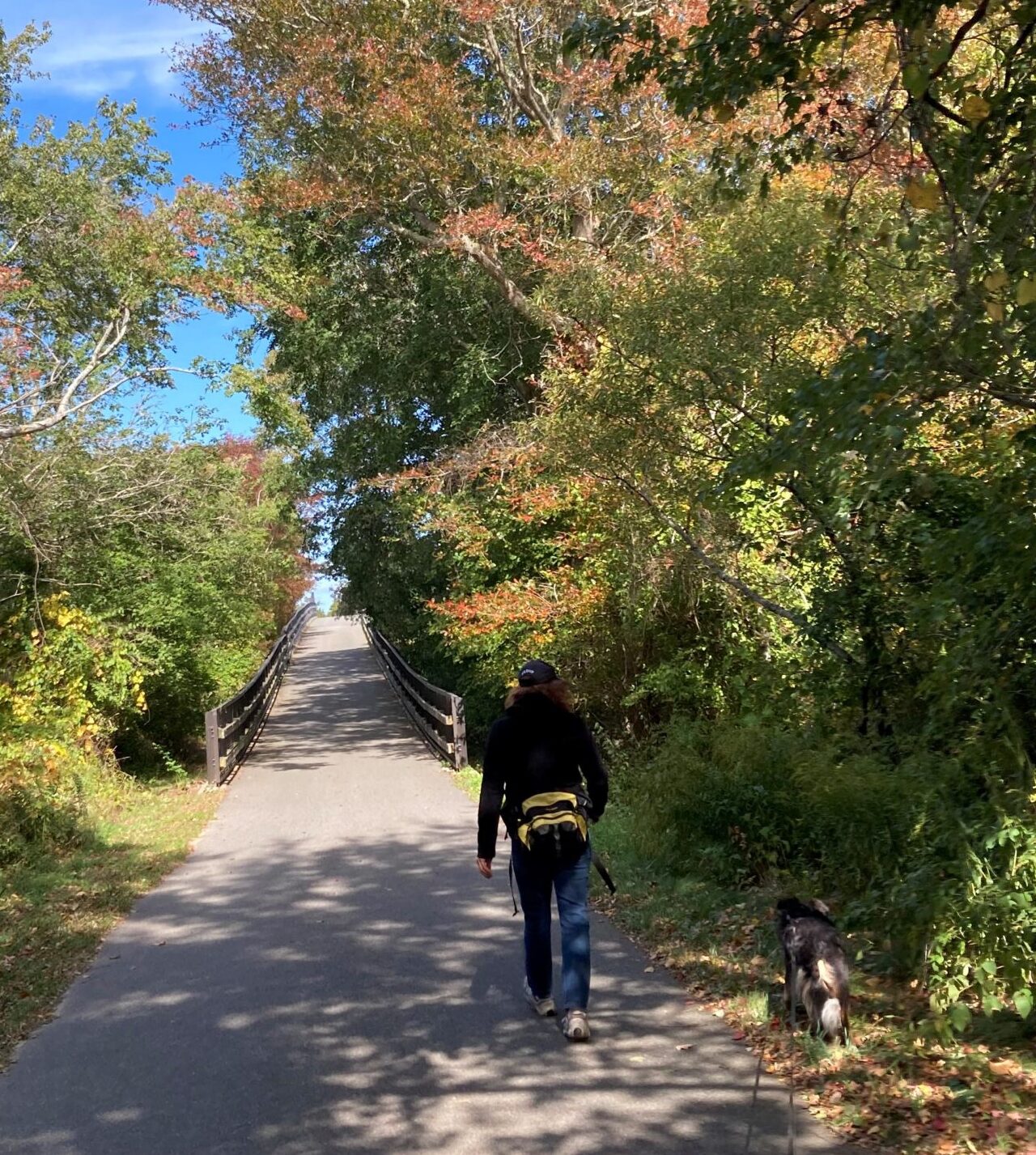Our Memories of the ocean will linger on, long after our footprints in the sand are gone.
-Anonymous
Four days after our Centerville to South Dennis walk, we’re back at it. Our goal is Orleans, about 13.4 more miles down the CCRT (Cape Cod Rail Trail). Phyllis has decided to join us again, which makes the trip so much more pleasant. The sun is out and the temperature is cool without being cold; it’s a beautiful day for a walk on the cape. Waldo is eager to go and seems very happy to be out here, but then he’s always up for a good walk. His shepherding instincts show themselves, when one of us ventures off to water the weeds, by anxiously trying to follow with a bewildered “Where are you going?” look smeared across his hairy face. The rest of the time, he’s trotting along on the side of the tarmac, looking for sticks to carry – two or three at a time.
We pass through Brewster, a town first settled in 1656 and incorporated in 1803. The town was named after Elder William Brewster, the first religious leader of the Pilgrims at Plymouth Colony. It had the first water-powered grist and woolen mill in the country, founded in the late 17th century. Helen Keller and her teacher, Anne Sullivan, visited the town in 1888. The population of Brewster is 1,961.
Our destination, Orleans, was first settled by Pilgrims in 1693 and incorporated in 1797. Not wanting a English name, as they were captured twice by the British during the Revolutionary War, they named their town after Louis Phillipe II, Duke of Orleans. In 1918, Brewster was shelled by a German submarine, the only attack on the continental US during WWI. I’m guessing they’ll not be eager to give the town a German name anytime soon. It is now home to 1,867 souls.
I’ve grown to really appreciate the rail trails in our country. What a great idea to convert old, unused railroad beds into paths that walkers and bikers can use. They’re all over the country and can be found easily on websites like www.traillink.com, or www.alltrails.com. The parent organizations provide maps and guidebooks and, through donations, are making even more trails available that run along the steam locomotive roadbeds of the not so distant past. In any event, we follow the CCRT, pass through some corrugated culverts and walk past flooded cranberry bogs. Waldo walks along the tarmac, surrounded by sandy berms bearing scrub pine and oak. His nose is to the ground and I wonder if he’s fascinated by the different smells of the seashore. If he is, he doesn’t show it. But, then, he lives in an olfactory world and seems fascinated by all odors. After 13.4 miles, make it to Orleans at the Dunkin’ Donuts where we left our car. We have a refreshing large iced tea, an iced decaf with oat milk for Phyllis, and a bagel with cream cheese, and we drive home.
Three days later, it’s on to the end of the CCRT in Wellfleet. On the way, we pass through Eastham. In 1620, a hunting party from the Mayflower, which was anchored in Provincetown harbor after a rough Atlantic crossing, met the local Indians, the Nauset, at First Encounter Beach. Eastham’s population is now 4,893. Further along our route is Wellfleet. Wellfleet achieved town status in 1763. Originally, oyster beds drove the local economy, along with whaling and fishing. The first transatlantic radio transmitter was built by Guglielmo Marconi, yes, that Marconi, on a coastal bluff in South Wellfleet in 1901-02. The first radio telegram was sent from America to England, from President Theodore Roosevelt to King Edward VII, on January 18, 1903. Former residents include Noam Chomsky, John Dos Passos, Guglielmo Marconi, Anthony Perkins, and many artists. Its population today is 3,481.
Phyllis was not able to join us on this leg, but plans to join us for the rest of the trip. It’s another fine day with warm, but not hot, temperatures, cloudy skies and only light winds. We are quite comfortable in our shirtsleeves, yet Waldo doesn’t require a lot of water. This walk is not as long as many of our more recent treks and we’re done in just over four hours. On the way, we pass by salt marshes and plod down long straight, narrow stretches of tarmac shaded by trees rooted in the soft sand. Oaks are only beginning to drop their leaves, which are mostly still green, and many others are conifers – scrub pine and western red cedar. A lot of bicycles pass us; this part of the trail seems to be quite popular with cyclists. Finally, we come to mile marker 22.0 and the CCRT ends. We’ll miss it, it was a beautiful path to follow.
Only two more legs to P’town, then a short walk to Race Point.



